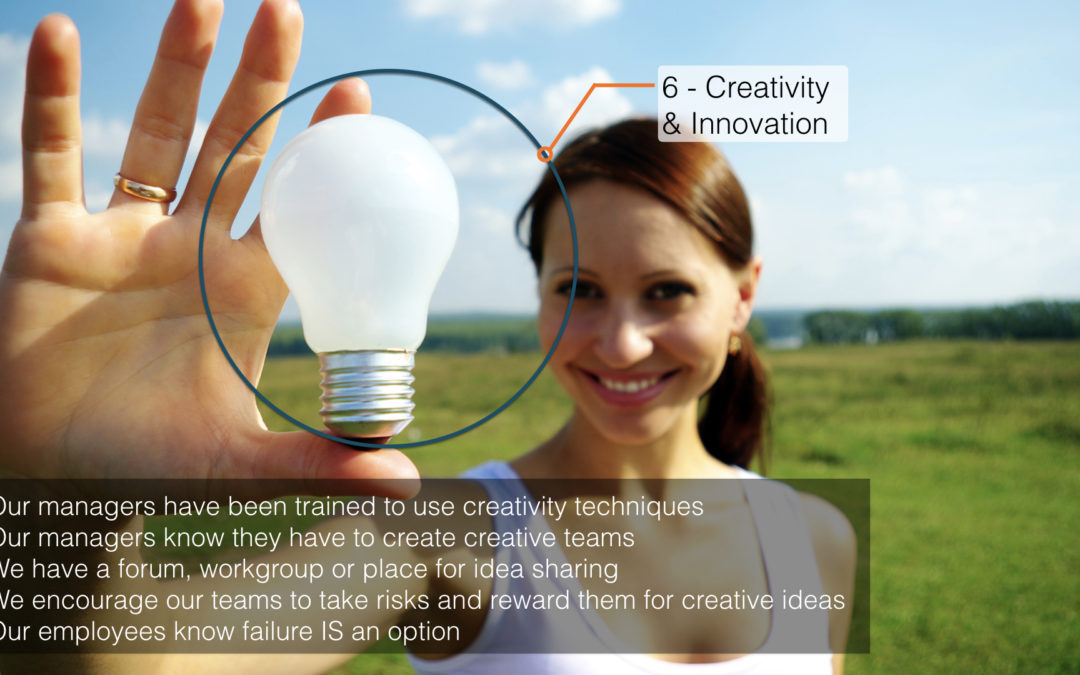Creativity & Innovation
“The difficulty lies not so much in developing new ideas as in escaping from old ones”. J-M Keynes
“My manager never comes back to me about the ideas I put forward”, “I’ll just take my ideas elsewhere, somewhere we’re not just expected to follow like sheep”, “OK, I get it. I won’t bother putting forward any ideas any more, because my manager just passes them off as their own”, “They keep asking us to be more innovative, yet they don’t give us any time to reflect”. Everyone knows that innovation is the key to being able to differentiate oneself from the competition.
Those in charge advocate boldness, creativity, ‘out of the box’ thinking, yet they never change their management style or practices. Many have implemented different platforms to allow staff to express ideas, yet management rules remain restrictive and staff opinions are often judged by experts according to their own personal experience, rather than presenting ‘weak signals’ or emerging trends. Is risk control truly compatible with boldness? Why is innovation still entrusted exclusively to those working in research & development? What is stopping companies from allowing other staff to get involved in idea generation?
Innovation is a spatio-temporal approach
- “Spatio” : innovation must be cross-functional and open to the widest possible audience. After all, anyone can have good ideas, regardless of their job, status or experience. Today it is more a question of mobilising the “wisdom of crowds” than of only affording experts the task of idea generation. Involving as many people as possible allows you to create an iterative process that allows individuals to feed each other’s creativity (one idea leads to another that leads to another). Did you know that the idea of using an electricity card in hotel rooms, to reduce electricity wastage, came from a housekeeper?
- “Temporal” : ideas can happen at any time, during and outside of working hours (in the shower, on the journey home, in the cinema …). Therefore, restricting the exploration of new ideas to a 2-hour meeting no longer makes any sense.
Finally, the less rigid you are in your framework, the more likely you are to find serendipity (i.e. find ideas you weren’t looking for or by mistake, like the post-it note, the microwave oven, or penicillin). As strange as it may sound, the best ideas often come to mind when you’re not looking for them…..
Three examples that may help you to encourage creativity and innovation
- In France, at Orange(the only telecommunications company that seems to have escaped the ‘Free’ revolution – luck or coincidence?), employees are free to express their ideas via a social innovation system called IdClic. It allows any employee, regardless of their status, seniority or job, to put forward an idea on an engagement platform. The idea is then studied by voluntary experts (of which there are around 5000 in total). If it’s not archived (no idea is considered bad), it is then subject to a feasibility study, which includes an estimation of potential net earnings. Once put into operation (the author of the idea automatically becomes part of the project), it can be deployed at national level. Since 2007, 1/3 of employees have submitted ideas (122,000 ideas have been received in total), and 10% of those have been used, resulting in hundreds of millions of euros of savings, which would never have been possible otherwise.
- At 3M, in the United States, the 80/20 rule is still practised. Initiated in the 1930s, the CEO of the time, William McKnight, had a saying: “Hiregood peopleand let them do their jobs “. In line with this belief, the company initiated a programme whereby employees were able to spend up to 20% of their time (i.e. one day a week) working on projects outside of their usual scope. This led to the creation of products such as the post-it note, which was actually invented by two chemists at the company in 1974 (today 3M sells more than 600 post-it note type products). This 80/20 principle was subsequently adopted by other companies, such as Google and Atlassian.
- In 2007, in the United States, DELL’s CEO Michael Delldecided to create an Internet platform called IdeaStorm, where he asked Internet users to post product reviews.This approach, which admittedly was rather bold and courageous (quite unusual for us Frenchies considering we have such an aversion to failure and mistakes!), allowed the company to identify causes of customer dissatisfaction and therefore find solutions. The second step was to involve customers in the search for new ideas, what we now call ‘open innovation’. Several ideas were selected from the 9,000 submitted and the initiative had a positive effect on customer relations. Therefore, when wanting to come up with new ideas, it is essential to go beyond the perimeters of the company. And let’s be honest, who wouldn’t want to contribute to a company they like when there is nothing personal at stake. Could this not be the beginning of a ‘idea-donation’ethos? Dell isn’t the only company to have taken this approach – companies such as Lego, IBM and Auchan have also gone down this route.



Thank you for some other magnificent post. The place else may anybody get that type of info in such an ideal means of writing? I’ve a presentation subsequent week, and I am at the look for such information.